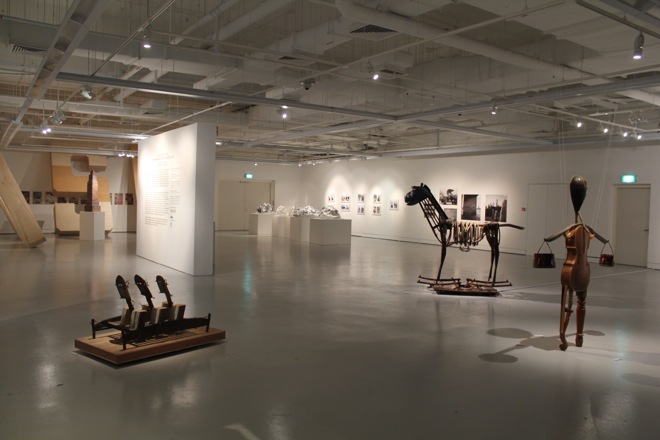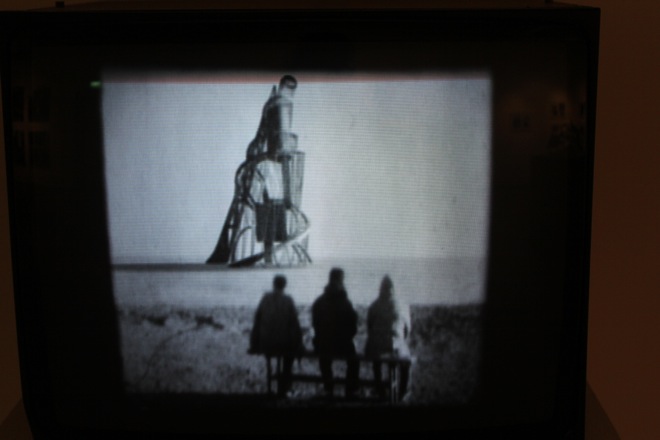“Lost to the Future: Contemporary Art from Central Asia”
Lasalle College of the Arts (1 McNally Street Singapore 187940) Oct 24 – Dec 10, 2013
It is satisfying when an exhibition looks beyond its own content to the context in which it finds itself. “Lost to the Future” was one such exhibition—a show of strong work from Kazakhstan, Kyrgyzstan and Uzbekistan curated by the former director of the Institute of Contemporary Arts at Lasalle College, Charles Merewether.
The soft power of government-backed contemporary art in Singapore is boosted and proclaimed through the Singapore Biennale, with the 2013 version entitled “If the World Changed.” A sanguine atmosphere pervades the event, this year with earnest regional sentiment rejecting national pavilions to embrace “the many Asias” in South-East Asia, leaving no one in the corner.
“Lost to the Future”, as the name suggests, brought a rather different tone. Asked about the intention, Merewether is clear: yes, the exhibition aimed to puncture the spirit of the Biennale. Central Asia is a world—to borrow from the Biennale slogan—which had already changed irreversibly in 1991 when the USSR was formally dissolved. The countries in the region continue to live in the shadow of the post-Soviet aftermath, caught between the partial dissolution of their own cultures and Soviet assimilation since the 1940s and the subsequent break-up of the USSR which had sought, often brutally, to unite them. They continue now in uneven states of re-formation, between lapsed utopianism(s) and practical necessity, with decaying buildings, toppled statues, relative freedom (or lack thereof), and uncompromising central Asian landscapes. In a region where, amid a forcefully changing socio-political situation, culture and economy have not served people consistently, how have the artists of these places attended to their cultures in recent years? In conversation following the opening of the show, Merewether remarks “The future is a big question.” His catalogue essay concludes with “This project belongs to an ongoing portrait of this long interregnum, an interval beyond the legacy of the past and the advent of the future. Waiting.”

展览现场

The exhibition showed the work of 12 artists and artist groups. The background to every one, we can surely assume, is completely removed from the lives of most people in Singapore. Part of the intrigue of these works, then, is just that—their difference and otherness, their unfamiliarity and their offer of sights and sensations not within one’s immediate experience. There is an element of voyeurism here which needn’t be suppressed: the exhibition was successful in feeling like a window onto not only the artistic environment of other places; it is strongly immersive in tone and texture—at times shocking—with a weight of historical event behind it, kindling one’s desire to become more informed.
Some of the works on show definitely command physical presence. Communism Peak (2009) by Erbossyn Meldibekov is a series of five overturned metal basins bashed in to create shapes like jagged mountains—marking and mocking the renaming of a peak in the Pamir mountains six times to serve varying political messages. In the middle of the room, Georgy Tryakin-Bukharov’s darkly retentive sculptures fashioned from scraps of wood and tools, such as “Mustang” (2003), assemble potent manual statements, their every part conveying its existence before and after the formation of the art object. As collages of disconnected and out-of-use tools and materials, they embody simultaneously a sense of aesthetic life and death or the passing of function.
The video works moved between imagined or dreamlike narratives and the real but reticent, delivered through memory and landscape. Noteworthy were two works by Almagul Menlibaeva. “Kurchatov 22” (2012), wherein the Soviet nuclear test site at Semipalatinsk becomes a vehicle both of documentary and evocation, is a desolate but compelling portrait. Menlibayeva’s “Transoxiana Dreams” (2011) depicts semi-clothed young women with shamanistic fox-fur masks and four legs who encounter an old Father as he searches for new fishing grounds in the Aral region. Once a fertile area, Transoxiana’s water was drained by the Soviets in the 1960s, resulting in total decline and deserted fleets. The video conjures an unusual mixture of the erotic and mysterious and a rather grim, pressing reality.
Also contributing video work to this exhibition was Saodat Ismailova, whose films “Zukhra” and “Gulchehra” (both 2013) deliver powerful visual narratives about women. The second film is split between two screens—one following a young girl, dreaming amid ordinary domestic activity, the other following people searching for her after her disappearance (a story based on real events after which the film is named). These beautifully and simply rendered videos feed through contrast one’s focus on those works which involve wider landscapes. The foremost of these is perhaps Gulnara Kasmalieva and Muratbek Djumaliev’s nine-minute five-channel piece “A New Silk Road” (2006), wherein huge lorries are seen careering along gaping, dusty roads; a lone rider and horse skitter across the path of a vehicle in a startlingly literal and furtive collision of past and present.
Compelling though its images are, a piece like this does beg the question of the contrast between works of “art” received in aesthetic or creative terms, and works that are compelling due to a certain historical or social fascination together with truths recounted from unknown places and distilled for the infrequent viewer. The photographs here by Ebossyn Meldibekov and Shailo Djekshenbaev are cases in point. Meldibekov updates, in the present day, old photographs of people in public squares, at a time before monuments and statues may have moved, changed or simply vanished through the machinations of politics (“Family Album”, 2007–9). Djekshenbaev documents unspectacular but remote lives—wedding days in his native Kyrgyzstan, for example, and a mental home (the series The Bride from the South, 1980 and Mental Health, 2007, respectively).
The appeal of this exhibition—at least initially—rested on the impressions it offered of other identities and situations. The works deliver collectively without gloss, with little that could have been called decorative; the tone was fairly grave, and urgent. These are works born of provocative environments and which provoke, especially in a different context like Singapore’s. Yet this foreign appeal was not its only compulsion, since the caliber of these pieces in their own right was also clear. Though the environments they describe might be said to be “Lost to the Future”, it is not trite to interpret the sight of these unfamiliar artists and works as a form of beginning—particularly given the relative lack of attention they have received internationally. When asked where he would ideally like to show the exhibition, Merewether remarks “There should be a place, but there isn’t.” Seldom does one have the opportunity to see the distinctive contemporary art from Central Asia, and this show only whets one’s desire to see more of it.
N.B. A Central Asia Platform at Art Stage Singapore—part of a new curatorial initiative by the fair for 2014 whereby experts in the field select work from different regions in context—will present video works by Askhat Akhmediyarov, Saodat Ismailova, Gulnara Kasmalieva, Almagul Menlibayeva and Muratbek Djumalie. “Changing Worlds: Contemporary Art From Central Asia” is curated by Charles Merewether.

